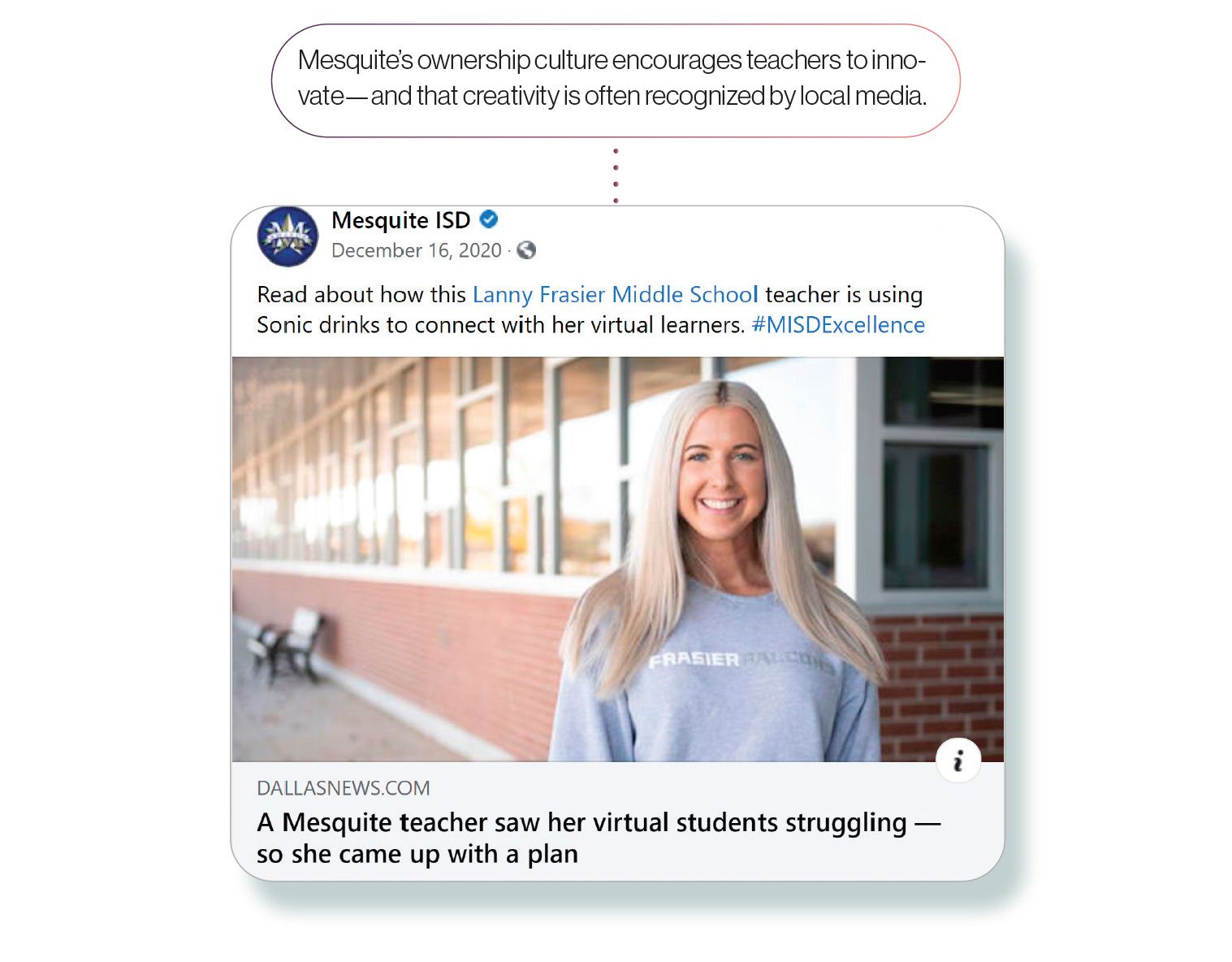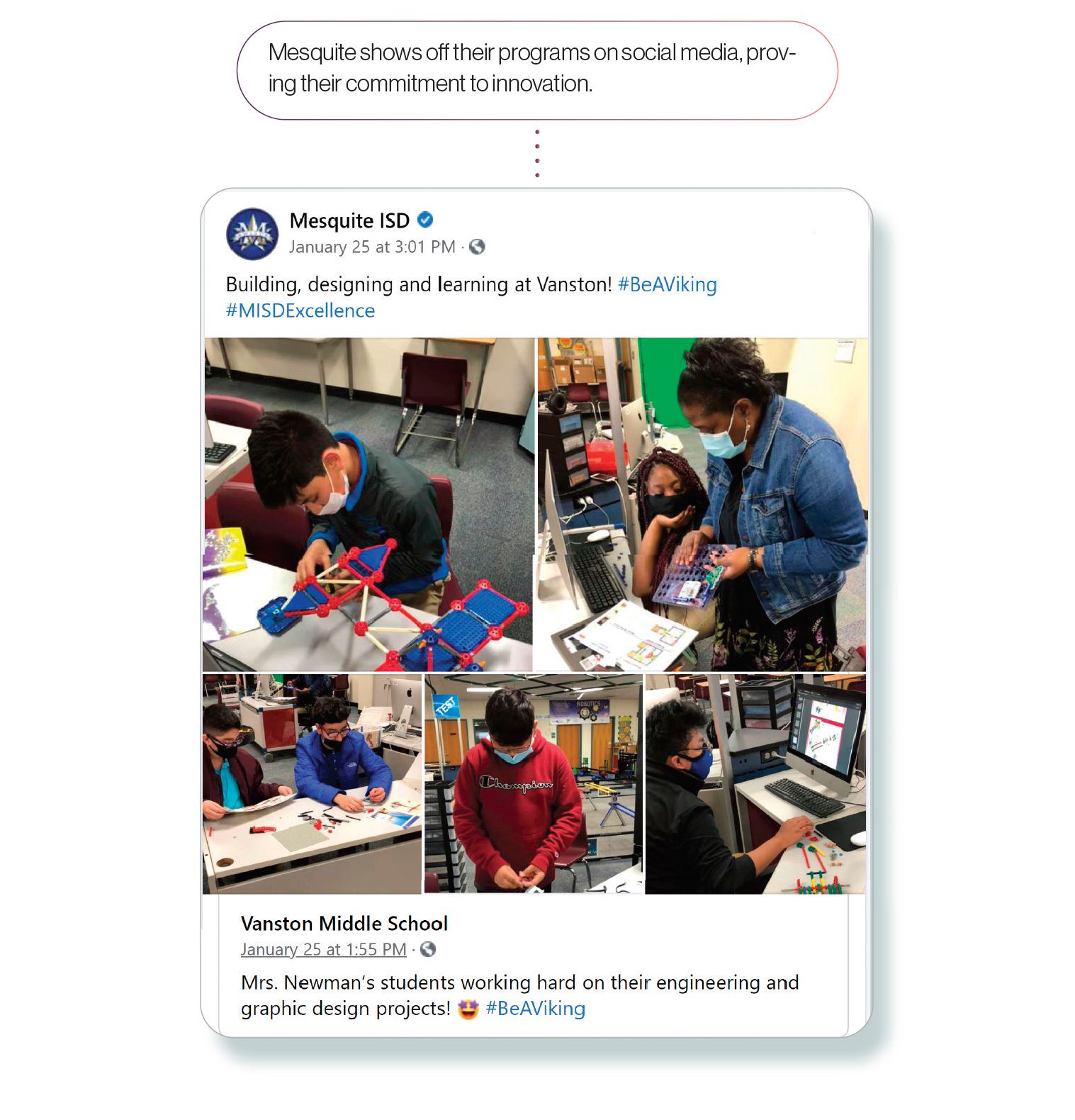Dr. David Vroonland: Turning on a Dime
How Dr. David Vroonland is building a culture of ownership that spurs innovation in Mesquite ISD

From the outside, Mesquite ISD seems like a typical Texas school district. They go big—MISD’s Memorial Stadium, the largest high school stadium in the state, seats almost 20,000 Mesquiters under its Friday night lights. Embracing the Lone Star State, district videos are narrated with a cheerful Southern drawl. The city of Mesquite itself hosts an annual rodeo, complete with funnel cakes and bull riding.
But like many suburban school systems across the nation, MISD’s demographics have shifted over the past two decades, bringing new challenges to the district. About 78% of Mesquite’s nearly 40,000 students are economically disadvantaged, almost doubling from the early 2000s.
Though families’ needs have increased, Mesquite is performing at record highs. MISD has a graduation rate of over 90%, and disadvantaged students in the district are outperforming their peers across the state. The difference, it seems, is the culture created under the leadership of Superintendent Dr. David Vroonland.
Just like his district, Vroonland is more than meets the eye. When he was about three years old, he and his siblings were put into foster care, where he lived in a house that was sometimes inhabited by up to 20 other people. At age 10, he put his belongings into two paper grocery bags and sat in the back of a car, alone, on his way to a new town and a new last name.
It was ultimately Vroonland’s experience in foster care that put him on the path to education. “I knew early on that school was my way of being as good as anyone, regardless of the circumstances of my birth,” he tells SchoolCEO. By the time he was 18, Vroonland had decided he would either be a doctor, a minister, or an educator. Luckily for Mesquite ISD and the thousands of students Vroonland has impacted in his nearly 35-year career, “educator” won out.
Today, MISD is garnering attention on the national stage for their strong culture and made-in-Mesquite innovation. However, the district’s most groundbreaking ideas aren’t coming from Vroonland’s office. Instead, they’re coming from classrooms, from the district’s counseling department, and from the people who make up Mesquite. Vroonland is building a culture of ownership that empowers his employees to innovate in their own spaces. The results, as you’ll find, are revolutionary.
Owning the Problem
In Vroonland’s first few years at Mesquite, he prioritized building an ownership culture—one which empowers staff to build their own solutions to problems within their realms of influence. “There’s nothing wrong with the language of buy-in,” Vroonland tells us. “But the problem with buy-in is that it’s often a sales job. You’re selling a solution to a problem that doesn’t exist in the minds of the people who are having to implement it. Instead, how do you build ownership around problems and solutions?”
When Vroonland arrived in Mesquite, the district was struggling to get kids on reading level by third grade. But instead of hiring an outside program or developing a solution in the central office, Vroonland got teachers involved from the start. “We were very clear from the get-go: We’re not bringing in a product,” he says. “We’re bringing in someone to help us work through the problems that exist.”
To make sure teachers understood the need, Vroonland gave them time to investigate the issue. “Instead of bringing a specific problem to teachers, we actually had them do research for two months,” he says. “Then, teachers presented to administrators why we weren’t getting kids to that third-grade reading level. Doing that got them to own the problem. And once they owned the problem, they could own the solution.”
Across the district, this mindset is resulting in new, adaptive systems. “We want to take leadership to the point of responsibility as much as possible, so that our teachers are actually able to drive innovation—to be highly nimble and responsive to the needs of students,” Vroonland explains. “You can’t design that from the superintendent’s office. If you attempt to do so, you end up limiting opportunities for young people because you designed scripted systems that slow down potential in the long term.”

Growing Capacity
Of course, many districts promote the idea of ownership. To Vroonland, what makes Mesquite uniquely successful is training. “A lot of people use the expression distributed leadership models,” he says. “But it still comes down to a question of how. So we focused a great deal in Mesquite on building the leadership capacity of our principals.”
Vroonland makes a concerted effort to train principals and assistant principals—about 130 site leaders in total—multiple times a year in evening sessions. The Mesquite team also hired four Executive Directors of Leadership Development to work with principals, and the district implemented monthly instructional leadership trainings. “It’s a remarkable investment that has really paid off quite nicely for us,” he says.
Recently, the district partnered with the Holdsworth Center, a leadership institute for education. When Holdsworth surveyed staff, the results were resounding. “The ownership culture came out loud and clear. We had the highest ratings of anyone they’ve ever surveyed,” says Vroonland. “When you start respecting the ability of the professional to innovate their spaces, people actually enjoy their work more—even if they take on extra responsibility.”
In partnership with the Holdsworth Center, Mesquite has designed a leadership track for teachers and administrators. Working independently or collaboratively with a campus leader, teachers can direct their own development, completing modules in line with Mesquite’s leadership profile.

“Part of what excites me about this is building more equity in our leadership pipeline,” Vroonland notes. “It will allow more people to self-identify based on actual data because of the work they’ve done to grow their leadership.” In addition, the district has invested heavily in instructional coaching, building capacity even for those who don’t enroll in leadership training. As a result, performance has skyrocketed and discipline issues are down—”all of that without a district-driven initiative,” he says.
This type of growth isn’t limited to teaching. Mesquite’s counseling program, for example, has been recognized across the state. At the high school level, counselors examined their practices and noticed holes in the system. Families needed mental health support, but many couldn’t afford individual counseling. “There wasn’t an initiative driven by the district; it was just our counselors saying, We need to do better for our students,” says Vroonland. Instead of buying a product or implementing a solution from the central office, counselors took ownership of their department’s outcomes. “We let our counselors identify the problem, and then our counselors became the designers of a solution,” he explains.
MISD has now partnered with Texas A&M Commerce to offer individual therapy for any student or family member at the district’s Family Support Center. “We now serve more than 2,000 families free of charge,” says Vroonland. “I’m proud of where we’ve come.”
Removing Obstacles
When ownership becomes less centralized, you may assume that implementation lags. But at MISD, the opposite is true. An ownership culture has made the district agile, allowing Vroonland to turn a big ship quickly.
When Vroonland first learned about the severity of COVID-19, he was actually on a cruise ship. “My wife and I made the brilliant decision to cruise out of New Orleans,” he says with a smile. They left on March 8, 2020. By March 10, Dallas County had announced their first confirmed case. Vroonland started getting calls on the ship, even though the district was closed for spring break. “Mesquite ISD hadn’t made any plans up to that point about closures,” he says. From the ship, Vroonland had to cancel school for the following week and inform staff they wouldn’t be returning that Monday.
However, the disruption wouldn’t last long. “I announced that we would return to learning by Wednesday,” Vroonland says. And they did—every one of Mesquite ISD’s nearly 40,000 kids. The district hadn’t previously been one-to-one, but within a week or two, each student had a device in hand. Meal delivery was launched in under a week. For their quick work, Mesquite started gaining media attention. The creativity of the district’s teachers during the pandemic even garnered national and international media coverage on the BBC and ABC News online.

For Vroonland, the idea that big ships are also slow ones just isn’t true—he’d seen his own cruise ship turn on a dime, even in a tiny port. “What is required,” says Vroonland, “is that the obstacles be removed.”
These obstacles often present themselves in the form of red tape and micromanagement. So Vroonland has “learned to remove some of the obstacles to innovation and leadership,” he says. Before he joined the district, for example, principals were expected to contact the central office if they were dealing with a discipline issue. To Vroonland, that step isn’t necessary. “As a principal, you have to own your decisions, and we’re going to support them unless you violate our core values,” he says. ”That reduced the amount of time they had to spend on phone calls back and forth. We actually reduced their tasks while giving them more ownership.”

Selling Purpose Over Strategy
Another mindset shift Vroonland encourages is to start with the why. “Sell purpose, not strategy,” he explains. “When you sell out to your purpose, you can change your strategy if needed.” Focusing on people, not numbers, gives Mesquite’s staff a clear target for growth. “We are not a data-driven district,” he explains. “We’re a values-driven district that’s informed by data.”
For example, the district values having students in the classroom. The point isn’t a high graduation rate; the point is to bring each student to the finish line. When designing processes and systems to keep students in the classroom, then, the team focuses on student needs first. The numbers only tell them how they’re doing.
“One of the problems with data-driven anything is you tend to have prescribed outcomes,” he explains. ”If you meet that outcome, you have the tendency to stop at that point instead of meeting the needs of everyone. That doesn’t happen in a value-based system.”
Vroonland gives the example of walk-throughs, where principals observe teachers in their classrooms. In his second month at Mesquite, he noticed that his principals kept warily asking him what he thought about them. “And I hesitated,” Vroonland tells us, “because I was thinking, Why are they asking that?” As it turns out, past leadership required principals to do 25 walk-throughs a week and report them to the district administration. But central office didn’t necessarily do anything with the reports, and principals were squeezing in most of their visits on Fridays—the worst day for walk-throughs— just to meet their quotas.
Vroonland immediately recognized the problem: Principals didn’t own the practice. “So we went into a conversation around the value of walk-throughs,” he says. For him, walk-throughs are an opportunity to collect data that tells the principals whether or not the district’s values are being represented. After that initial chat, he kept the conversation going, continually prioritizing this idea of ownership. Over the next two years, he met with principals often, “pressing this thinking throughout the system”—and as a result, they started to understand the why. Now principals complete an average of more than 25 walk-throughs a week. “We’re shifting thinking from being centralized to being owned,” he says.
Adding Accountability
While ownership does give principals and teachers freedom, that freedom exists within a specified box. “You have to have frames of operation,” Vroonland says. “It’s not a free-for-all.”
Once the central office built this framework, Vroonland emphasized the importance of consistency. “The tenets that you have in place have to be clear, and they have to be adhered to,” he says. “If they’re not, then people are really going to feel like there’s been a violation.” At Mesquite, that meant following through on the promise to decentralize quickly. “One of the most important things we did was hold ourselves accountable to decentralization when we could,” Vroonland explains.
When Vroonland needs to deviate from the ownership model—to implement new programs due to COVID-19, for example—he’s upfront about it. “I overtly communicate,” he says. “I explain that it is not in line with our behaviors or values, but in order for Mesquite to respond quickly as an organization, we need to put systems in place. And I remind them: As our capacity builds around these systems, we can start backing off and decoupling from that bureaucratic structure.”
Unifying the System
Recently, MISD has focused on bringing their culture of ownership to students. Through a partnership with Google and tech company SoftServe, the district formed the AYO program, named for a Yoruba word meaning joy. This program focuses on uncoupling students’ learning from standardization. Using artificial intelligence, AYO helps identify students’ backgrounds, mental capacities, interests, and skillsets. This information allows teachers to customize learning based on students’ passions and aptitudes.
To explain the program, Mesquite ISD created an Inspiration Book showcasing how it could affect individual students. They give the example of Emily, a student with an aptitude for design. Through the AYO system, each of Emily’s teachers would learn that she’s an only child; that she does well in English, art, and technical theatre; that she enjoys making and watching movies; and even that she is annoyed with the district’s dress code.
With this information in mind, teachers can facilitate students’ learning on a track that combines their passions and aptitudes—setting them up for success. In Mesquite’s example, Emily shows aptitude for high-level design, so teachers give her the platform to explore career options with an internship at a local architecture firm. They help her get certified in Adobe Premier Pro and provide her with a path to gain experience in audiovisual production. Working with her strengths and interests, Mesquite can help Emily drive her own learning.
“We’re designing a system that we believe will really give students strong agency over significant components of their learning,” says Vroonland. “It’s an example of ownership being pervasive in everything we talk about here.”
AYO goes beyond aptitudes; it also addresses issues of equity. “If we’re serious about equity, we need to understand that the system in which we’re operating was never designed for it,” says Vroonland. “The design mechanism of standardization was, frankly, to create ranking systems. It designated who was going to be the owners, the managers, and the workers. If you’re trying to get equity inside a system not designed for equity, you’re wasting your time. You’ve got to decouple from standardization.”
More than anything, the point of AYO is to help students figure out who they are. “Agency is only found where one has passion,” says Vroonland. “You don’t seek agency in something you don’t care about. No one does. Simply giving kids more choices in class isn’t giving them more agency. Agency is when one takes control over their learning. And that’s found in your passion—no other place. As a district, we have to help students uncover who they uniquely are. With AYO, we’re trying to help students do just that.”
Building Community-Level Ownership
Vroonland is vocal about the need for local ownership not just in the classroom, but at every level of a school system. “If you’re going to drive significant change in the system, ownership has to occur at the community level,” he says. In response, Mesquite ISD actually created their own accreditation and ratings system. Instead of relying on A-F scores from the Texas Education Agency—which are highly tied to standardized testing data—MISD schools are scored on a framework built by the Mesquite community itself.
Building the framework took several years, requiring intense research and surveying. Finally, the MISD community narrowed down new metrics to measure a school’s success: student learning, professional learning systems, student involvement, community engagement, safety and well-being, and fiscal/operational systems. Based on these standards, the school board accredits each of the district’s schools individually. “The public values so much more than the state testing system,” Vroonland explains. MISD’s new accreditation system puts power behind those other values, allowing the district to focus on students’ educational experiences.
To Vroonland, the importance of public education is deeply personal. “The fact that our republic created a system of public education communicates strongly how much we care about the individual as well as the corporate needs of our people,” he says. ”That’s an important piece of my life. Without it, there’s no way I would have gotten out of the circumstances of my birth.”
Leaving a mark on public education is a passion that gives Vroonland agency of his own, too. “Creating opportunities for students to gain control over their lives has been a driver for me for 34 years,” he says. “To me, public education is a way in which a community tells its youngest and most vulnerable, We care about you. We love you. We’re going to meet your needs. That’s why public education exists.”

SchoolCEO is free for K-12 school leaders. Subscribe below to stay connected with us!

